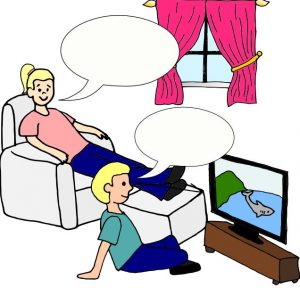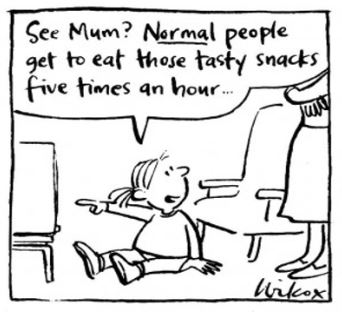 As we are spending so much time at home, we are facing the dilemma of how to keep our children entertained. Thoughts of children sitting in front of a screen while many parents are still trying to get some work done dredges up mixed feelings. At least they’ll be entertained and kept out of mischief, but we know that too much TV cannot be a good thing. But TV does not have to be only negative. Television (with controlled and limited screen time) can be part of a balanced program for kids. You can actually support your child’s language skills when you watch TV or movies together! Keep reading below or click here to download a handout on supporting your child’s language when watching TV or movies and handouts for other activities.
As we are spending so much time at home, we are facing the dilemma of how to keep our children entertained. Thoughts of children sitting in front of a screen while many parents are still trying to get some work done dredges up mixed feelings. At least they’ll be entertained and kept out of mischief, but we know that too much TV cannot be a good thing. But TV does not have to be only negative. Television (with controlled and limited screen time) can be part of a balanced program for kids. You can actually support your child’s language skills when you watch TV or movies together! Keep reading below or click here to download a handout on supporting your child’s language when watching TV or movies and handouts for other activities.
Here is how to support your child’s langauge while watching TV or movies
1) Watch TV with your child.
- Watching TV with your kids allows parents to check the content of what they are viewing and allows parents to provide input, guidance, and perspective on what they are seeing.
- Children who watch educational programs in the company of caregivers actually learn more from the material than children who view without co-viewing caregivers. Why? Children pay more attention to the TV, and view the material as more important, when a parent/caregiver watches with them.
2) TV can help kids learn about a variety of subjects.
- If there’s a subject your child enjoys, more likely than not, there is a TV show, movie, or educational YouTube clip that explores the subject in detail. You might even be surprised to find out how many kids watch and love educational shows aimed at adults – “Masterchef” and “Who wants to be a Millionaire” come to mind.
- Most children are not able to visit the rainforest or see a giraffe in the wild, but many have seen these things on TV.
3) TV can help build analytical thinking skills.
- Asking questions such as “What do you think will happen next?” “Who did it?” “What will the result be?” “What could that character have done instead?” will help children learn to think, problem solve, and predict, making TV viewing a more active experience.
- Compare and contrast: Develop these skills by comparing characters in movies, sitcoms, or even reality shows. You can make a character wall or chart to provide a visual support as well.
4) Use TV and movies to motivate children to read books.
- Many movies and TV programs are based on books. Encourage children to read the book on their own or read the book with younger children, then allow them to see the movie. Discussions comparing and contrasting the book and the movie will facilitate language development and thinking skills.

5) Discuss advertising.
- Young children often do not understand the difference between the TV programs and the commercials. It is important to discuss the role and purpose of advertising.
- Thinking skills and creative skills can be developed in older children by discussing and analyzing the methods that advertisers use.
6) Good role models and examples on TV can positively influence children & teach social skills.
- Children are influenced by people they see on television, especially other kids. Obviously, this can have a negative result, but it can be positive too. As kids see their favorite characters making positive choices, they will be influenced in a good way. Parents can also point out positive traits that characters display and thereby spark valuable family discussions
- When children of the same age all watch the same program, they talk and recreate parts of that program in their play. This is important for group inclusion as well as the development of social narratives.
7) You can stop and re-watch the action to give your child time to understand what’s happening.
- Social situations in real life do not have a pause button, and kids with language difficulties can struggle to keep up with conversations and games that evolve rapidly. Using movies, TV shows, or YouTube videos can allow you to pause the action to discuss what’s happening and why a character may have reacted in a certain way. You can draw attention to facial expressions paused on-screen or go back to watch or listen to a scene again and get more clues.
- Drawing a thought bubble prop and keeping it handy while watching a show can allow you to pause the action and hold up the prop as a visual support to help the child take the perspective of the character and fill in what they are thinking.
- There are many high-quality animated short videos on YouTube that do not have a lot of language in them. This can provide an excellent opportunity for a child to practise narrating, story-telling, or providing “voice–overs” for the characters, and for them to use their inferencing skills to notice details visually in the films. These shorts can also be a good length for summarizing or practising identifying the main idea. Try having the child practise telling what happened in the video, then going to tell a family member who didn’t watch it.
- Here is a playlist of some YouTube shorts you might want to try. Remember that YouTube is always changing and content being updated. Always preview a video before you play it for a child and minimize any ads that may pop up.
8) TV shows can inspire kids to try new activities and engage in learning.
- Children enjoy learning activities more if it involves their favourite characters. TV characters can be very motivating especially for younger children, which you can use by pulling the characters into other, non-TV activities. For example, print out and colour pictures of favourite characters then make up your own stories and adventures with them, or act out scenes from an episode!
9) TV shows can provide motivation to work on speech sounds.
- If your child is working on speech sounds, challenge your child to listen for their sound and make a list of words with their target sounds while watching a program. You can help! For non-readers/non-writers, it is perfectly acceptable to draw the words as well if that will be more motivating and easier for them to recall.
Leave a Reply